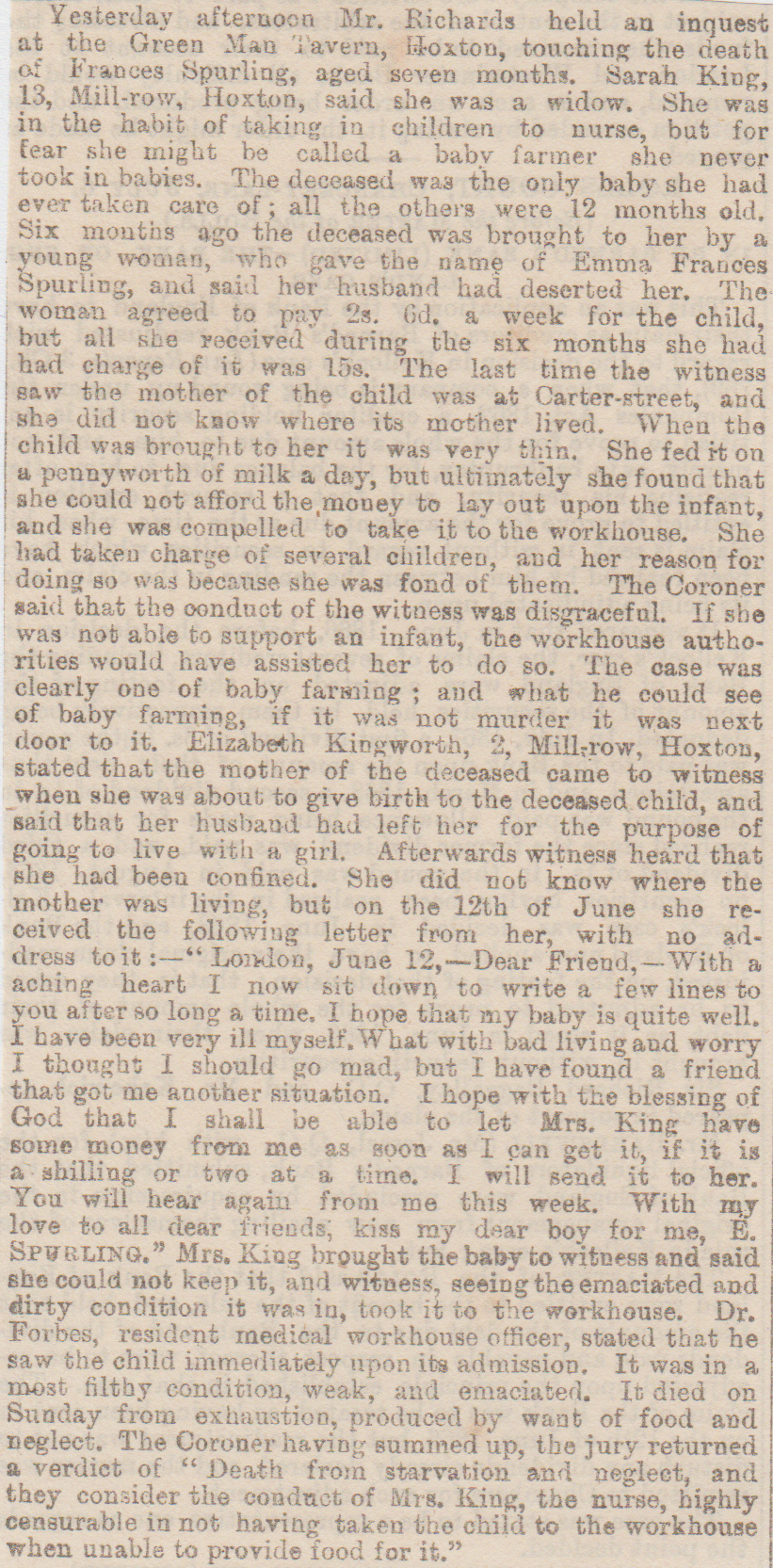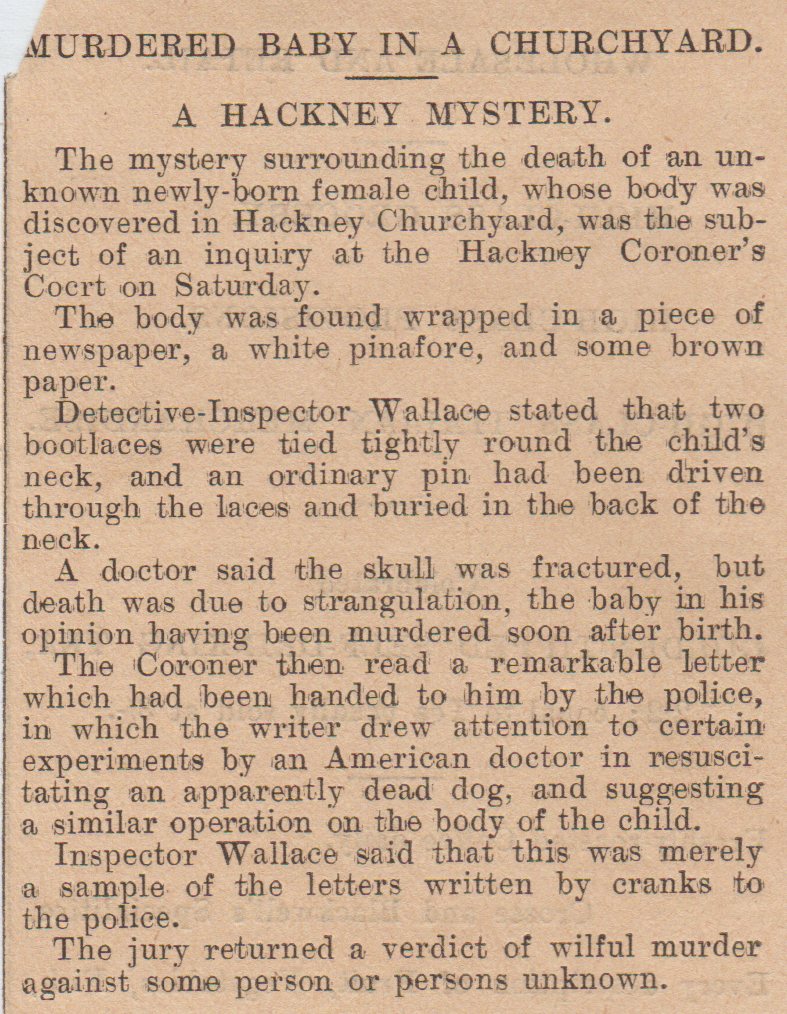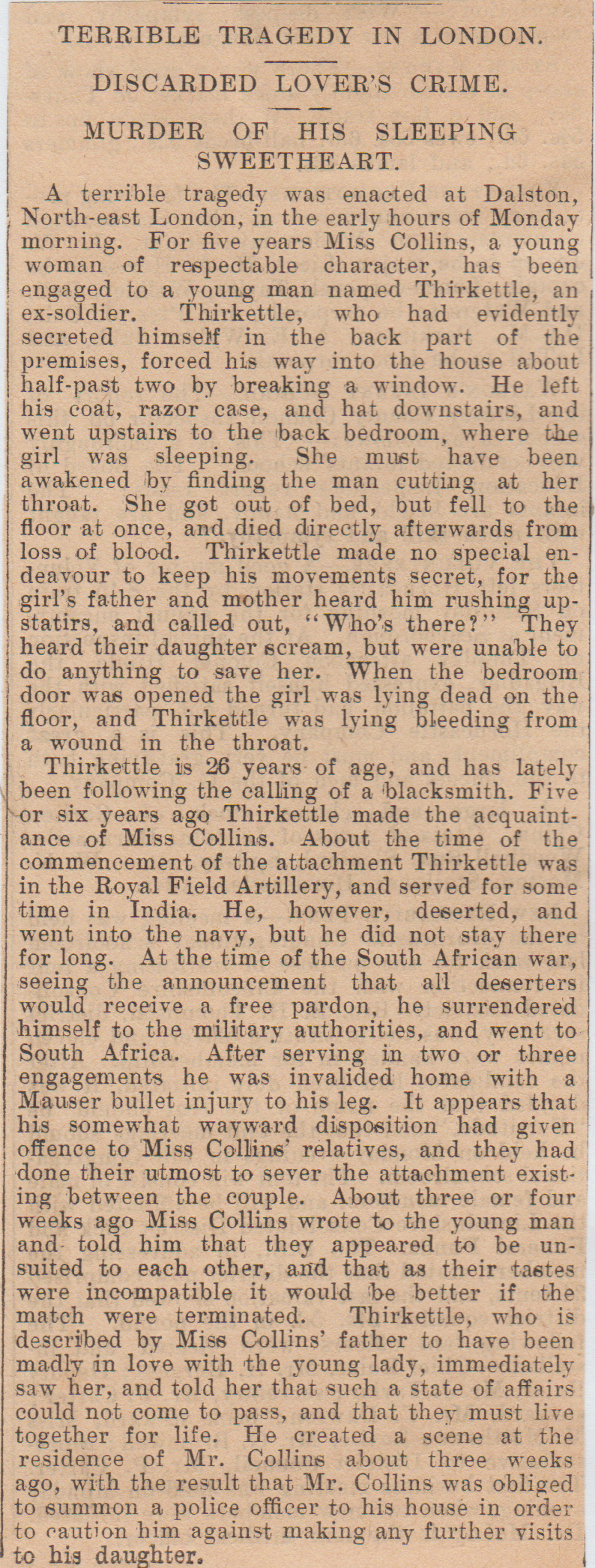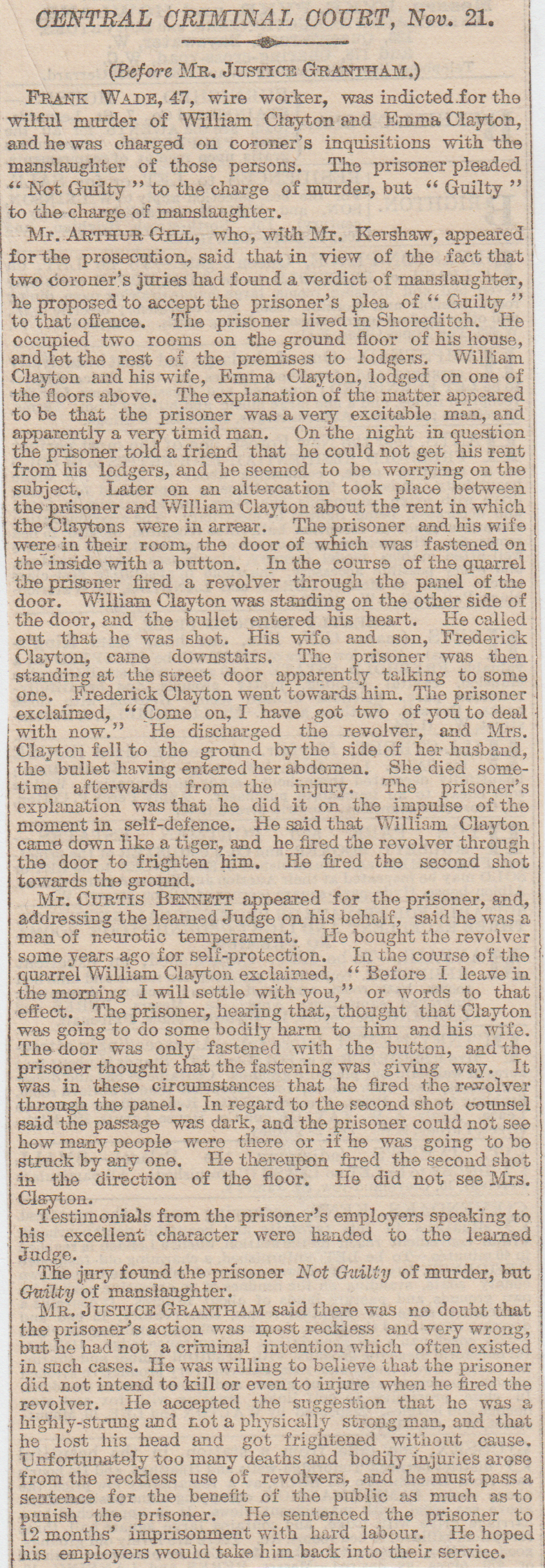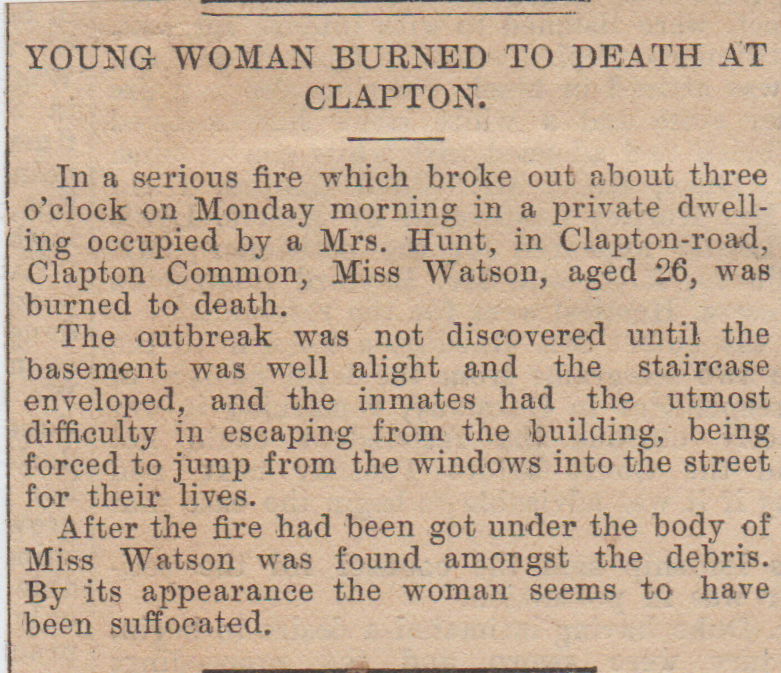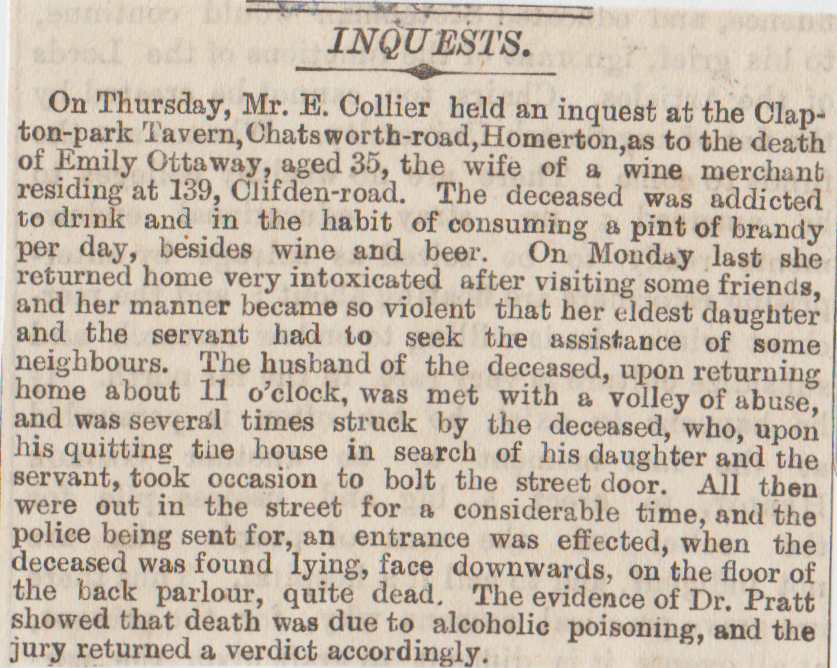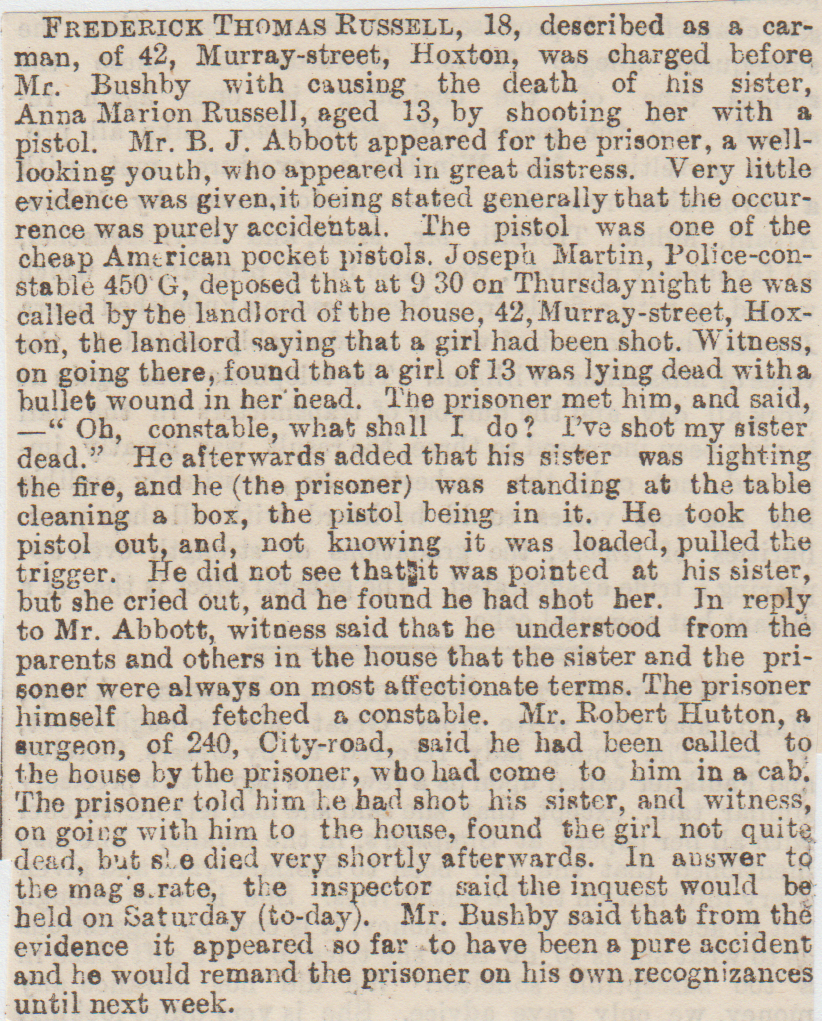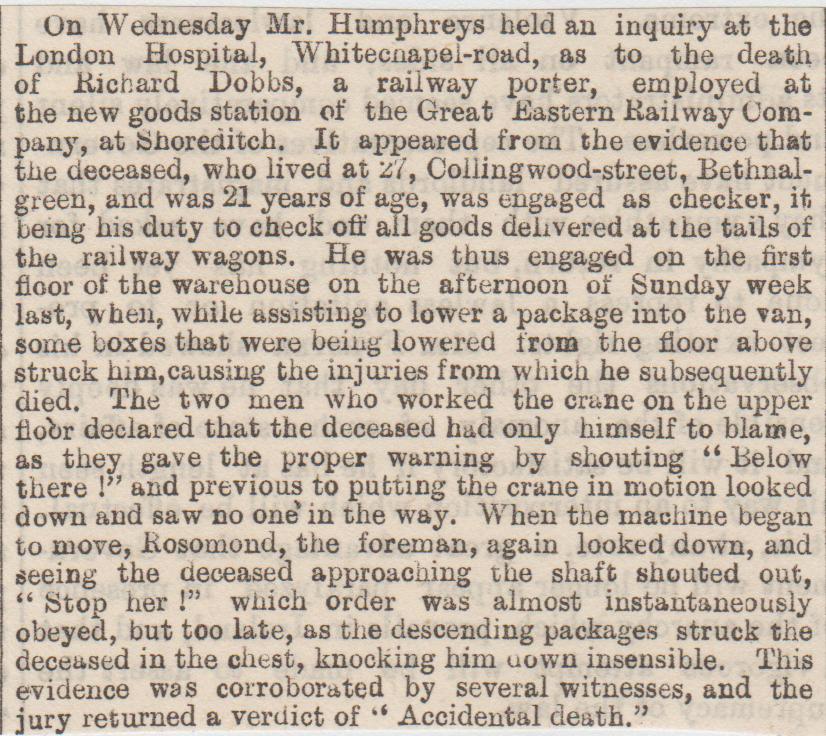1/ Hackney, August 1903 (Dead Body in the House for Twenty Days)
The body of Martha Crowe aged seventy-seven, a widow, had lain in her home undiscovered for nearly three weeks. Her nephew, Frederick Gardener of 185, Downham Road stated she lived on a pension. The lodger, Isabella Smith had lived there for two and a half years at 41, Downham Road. Martha went to a wedding on the 2nd with Smith, then afterwards Smith went to a relative’s. When she returned next day nothing was seen of the deceased Smith thought she’d gone away. A friend asked about her and when they realised they had not seen her for nearly three weeks they broke the door down and found her badly-decomposed corpse lying in bed. She was in the act of getting dressed for bed when she keeled over and died of “natural causes”.
2/ Amhurst Road, Hackney, April 1885 (Death in Sewer).
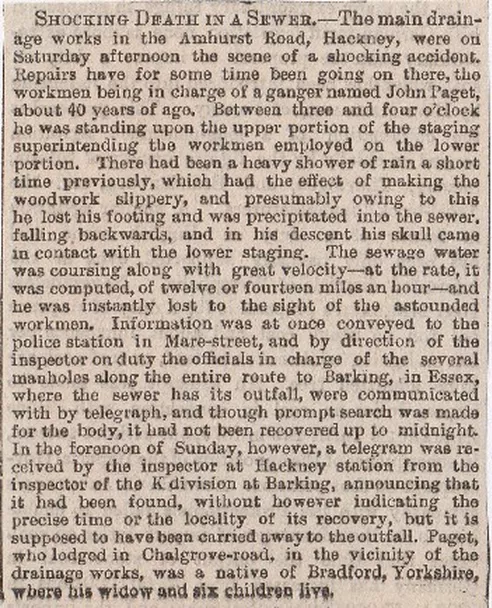
3/ Hackney Asylum Suicide, October 1864
A lunatic inmate from the Asylum at Hackney went on a hunger strike about five weeks ago, and yesterday he finally died. He was force fed time and again but he gradually got weaker and weaker.
4/ Hackney, December 1916 (Dies While Committing Suicide)
Robert Crisp was killed by excitement and of natural causes whilst attempting to commit suicide. He had a heart condition, and it so seriously affected his life that he wrote in his suicide note:- “I am a human wreck. I cannot be a burden to my wife any longer, so I think this is the best way out”. He bent a gas pipe to pump gas into his mouth and was sitting in a chair when he had the heart attack. A verdict of “Natural death”.
5/ Hoxton Asylum Murderer, July 1858
The lunatic Henry Arnold who managed to escape from Hoxton Asylum then beat to death a young lady at Broxbourne in Hertfordshire whom he met on the road, was committed for wilful murder. When the judge asked if he had anything to say, he replied “I suppose I must say I’m insane mustn’t I?”, and also added “That asylum is more like a robber’s house than an asylum. They have a man there who has £5-6000 in the bank and they give him the stuff to make him silly so that he doesn’t know he is about”. Not once did he mention murdering the girl and is clearly insane.
6/ Lordship Road Murder, Stoke Newington, March 1885

7/ Hackney Road Fire, London, August 1885
A fire occurred last night at Schreiber’s stick manufacturers, Hackney Road, London.It is feared that some children have perished in the blaze. (How many died?)
8/ Stoke Newington, June 1888
A man named Lake living at Stoke Newington shot his wife on Friday with a revolver and then killed himself.
9/ Farleigh Road, Stoke Newington, October 1884 (Botched Abortion)
The post-mortem on the body of Miss Matilda Wood, of Farleigh Road, Stoke Newington revealed some strange results. She lived with her sister and was due to get married to Mr Creed. Matilda began to get violent pains in her abdomen and despite the attention of the doctor she never pulled through. Death was due to a laceration of the uterus by the use of improper instruments by some person. It sounds like a botched abortion by somebody who didn’t have a clue what they were doing. The verdict returned was “Wilful murder against some person or persons unknown”. (Was it the sister or boyfriend?)
10/ Shoreditch, (Nine-year-old’s Suicide) April 1846
This is one of the youngest suicides I think I’ve come across doing the newspaper clippings. William Thomas Figges, aged nine years who lived with his Mum at 16, Vincent Street, Shoreditch. His father had legged it about four years ago and never got back in contact. He asked his mum for a half-penny to but a rubber ball but she said he couldn’t, so he left the room in a mood. Five minutes later a young lad found him hanging from a bannister by the neck, and they tried to resuscitate him but he was already dead.
11/ Dalston Murder, March 1885 (See also City of London-Newgate Execution of Henry Alt)

12/ Dalston Junction Fatality, September 1896
An appalling accident between Dalston Junction and Haggerston one Saturday night caused the death of a North London Railway guard named Cook. It is believed he was looking out of the window of his van and he suddenly went dizzy and fell onto the tracks, when another train passing in the opposite direction went over him, decapitating the unfortunate chap.
13/ Chatsworth Road, Clapton, March 1895 (Human Remains- 35 Sacks of them)
The new owner of a building in Chatsworth Road, Clapton, decided to take a look in the cellar despite the previous owner telling him to stay out of there because he had stuff down there that he didn’t want disturbing. On checking it out he found thirty-five sacks full of human bones and skulls. The ex-owner was a greengrocer, but now had some serious explaining to do to the local police. That amount of bones and skulls suggests to me that the guy was grave-robbing because if they were bodies and had flesh on them the stench would have been unbearable. (Was he a grave-robber?)
14/ Hackney Road (Arsenic Suicide)June 1863
Eliza Robinson aged eighteen was due to be married to her sweetheart about six weeks ago but he died suddenly. Eliza was very much in love the young man and was inconsolable at his death and has seen her take a steady decline in her health since the death. Eliza spoke of him constantly and never believed that he had passed away. On a Sunday evening, her mother Charlotte, of Westmoreland Street, Hackney Road, noticed her retching, but the daughter never complained of any illness. Early next morning she told her that she had swallowed some arsenic, but she told her she was way too late and she died within the hour.
15/ No.20, Margaret Street, Hackney, September 1863
This is quite a sad tale of the suicide of 42-year-old Edward Goodman. The witness in this instance is George Wiltshire aged thirty-one, of Margaret Street, said that Goodman had bought an old pistol from an antique shop for a few shillings. The same evening Wiltshire noticed a throng of people outside Goodman’s house at No.20, Margaret Street, and when he went upstairs to find him he was laid on the floor with his head to the door of the cupboard in a pool of blood. He obviously overloaded it with gunpowder because the clothes were charred and still on fire when he got there. It recoiled through the cupboard and broke the handle off, which rendered it unfit to re-use. Goodman shot himself in the heart and hadn’t left a note of any description but left some cash in his pockets. The sad part is that he was a bricklayer and had a nasty accident while working in the sewers. This caused his skull to be diseased and decayed and he had to have two plates in his head to protect the brain. He used to suffer fits of delirium and even after one glass of beer, which is what he had on the day of his suicide.
16/ Hackney Heath Deaths, August 1890
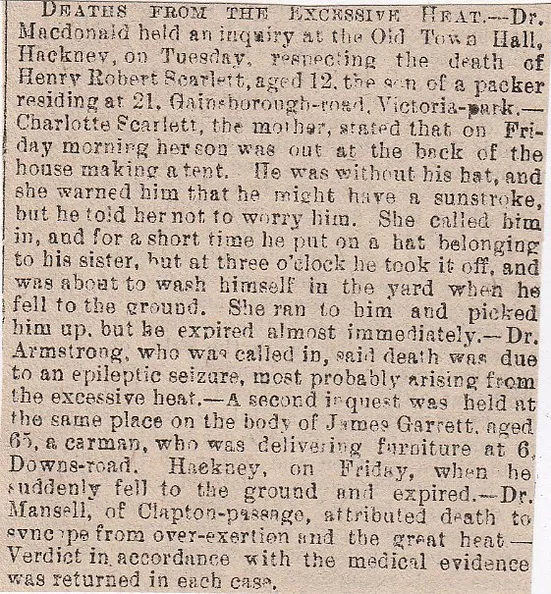
17/ Homerton/Duckett’s Canal Suicide, December 1863
Not the first and not the last tale of a domestic servant pinching stuff from their place of employment, then being found out and being afraid to go home, so they commit suicide. Teenager Amelia Walker had got a job with Mr Harling, The Retreat, Homerton and had only been there six weeks or so when the mistress of the house noticed little things disappearing, like candles, paraffin and some tea. The final straw came when she found a couple of pots of jam in her box so she had to fire her. Amelia left the house and Mrs Harling presumed she’d gone home. Amelia didn’t go home as she was that scared of what her Dad would do to her (he usually took off his belt, and thrashed her). Mrs Harling said afterwards that if she had known about the domestic situation at home then she wouldn’t have let her leave her house. Amelia thought that drowning herself in the canal would solve everything. She was fished out of Ducketts Canal with her wages still in her pocket.
18/ Hoxton Lunatic Asylum Suicide, May 1862
64-year-old Richard Bentley was an inmate at Hoxton Asylum and he killed himself by hanging, but here are the circumstances why he did it. He had been suffering from insanity for the last 16 years and was a patient at St Luke’s when they sent him home to Bury St Edmunds and prescribed the all clear. He was soon back to his old ways and tried to commit suicide by hanging himself from a beam but that snapped, and the attempt ended in failure. He was arrested for attempted suicide and sent to Hoxton where he was allowed to wander about unguarded and even leave the Asylum altogether. Bentley never turned up for dinner one day so a search was made around the Asylum grounds and he was discovered hanging from the bars off the ventilator. At the coroners’ inquest, it was mentioned that two years ago three people had hung themselves within a month of each other (Two patients and one servant). It was questioned why he was allowed out on his own, and the reply was that it part of a curative treatment, which was forward thinking for Victorian mental institutions.
19/ Hoxton Asylum, October 1897 ( Who was he?/ Did she die?)
20/ St John’s Church Fatality, Hackney, December 1877
A singular accident occurred at St John’s Church in Hackney which resulted in the death of the sextoness. Elizabeth Goodwin, aged 56, was the sextoness, and also in charge of the keys of the mausoleum. Two gentlemen arrived one day and wished to enter the Marquis of Downshire vault which had not been opened for a century or more. Goodwin took Mr Atkinson and Mr Buck into the mausoleum and while they were casting an eye over it they walked over a stone slab, which promptly collapsed and sent them twelve feet below. A ladder was procured and Mr Buck came straight out with a slight head injury, but Goodwin was jammed between two coffins with the stone slab upon her chest. She was brought out unconscious and died less than 20 minutes later.
21/ Dalston Child Murder, October 1899
A dreadful murder was committed at Dalston Junction on the North London Railway. Two young women asked a porter to open the door of the lavatory in the waiting-room as it appeared to be locked or jammed. When prized open the porter saw the body of a young lad who was completely naked except for a shawl placed over his corpse. The body was still warm and the doctor estimated time of death to be a couple of hours ago. He had been bashed about the face and a serious one on his forehead which looked like they had been made with a brick. Two bricks lay next to the body. It is believed to be a woman that did this heinous crime, as the woollen shawl left behind belonged to a female. The boy is about five or six years old, fair hair, and fair complexion.
November 1899
Louise Masset aged thirty-two and a governess, was charged with murdering her illegitimate child, three and a half-year-old Manfred Louis Masset at Dalston Junction Station.
22/ No.40, Myrtle Street Murder, Hoxton, October 1902
This is a weird case of, possibly suicide, but more likely a murder. The nearly decapitated body of Thomas Lawson was found by a lodger at 40, Myrtle Street in Hoxton.The wife and four kids had gone away to Kent to do some hop-picking about a month ago and Lawson carried on as usual, with nothing strange happening in those few weeks. One night a telegram was received and the lodger took it up to Lawson, who never answered when he called him. He gently pushed open the door and there lay the decaying corpse of Lawson on the floor with his head nearly severed from the trunk. By the side of Lawson was a fish knife. The doctor’s estimate of his time of death was approximately three or four days ago. (What about the smell?) The telegram was from his missus saying she’d be back home that evening. The three wounds to his throat do not indicate suicide as they were deep and ferocious gashes.
23/ No.126, St John’s Road, Shoreditch, August 1885
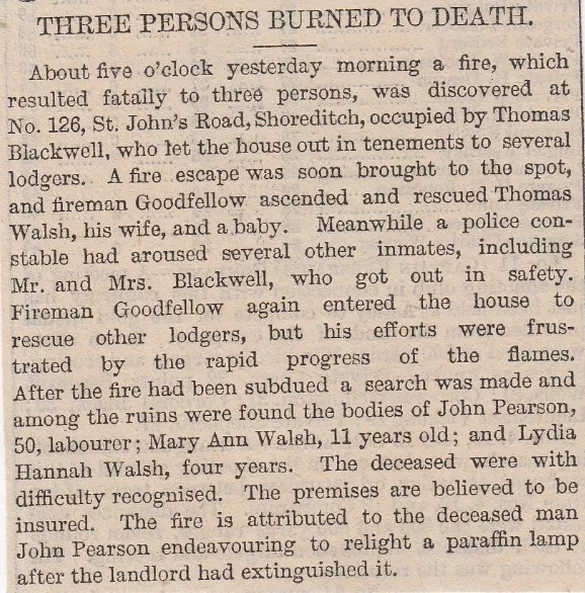
24/ No8, Grove Villas, South Hackney, (Child’s Skeleton) September 1867
The gruesome find in the cellar of No 8, Grove Villas in South Hackney was the talk of the neighbourhood and had locals gossiping among themselves. A child’s skeleton was discovered by the mother of the charwoman, in a hamper basket tied with string. The little corpse was wrapped in a piece of old flannel, and when she told Mrs Butley she told her to put it back until Mr Butley went out. Mrs Butley inquired as to whether it could be burned but the woman said the smell would be horrendous, and then she said:
“Never mind, I’ll take it to the new house and bury it in the garden where it will never be found”. As it turns out it could well have been her mothers, as she was in a relationship with a contractor and they used to get drunk together, and one thing led to another. They lived together for three years and Mrs Butley got her mother to leave him eventually, and the hamper could well have been part of her mother’s furniture. The post-mortem was awkward due to the age of the skeletal remains of the child, but it had no violent marks or fractures, and the flesh had been pecked clean by a hen that was kept down in the basement.
25/ Metropolitan Baths, Shoreditch, July 1849
Henry Johnson, a surveyor, aged fifty-one, killed himself in a very singular manner at the Metropolitan Baths, Ashley Crescent in Shoreditch. A waiter at the Bath, named Pamplin, said that Johnson was the surveyor there and also had helped draw up the plans to build them. One morning he visited them and went into the private baths, but later on that afternoon, he was found floating on the surface, dead as a dodo. He had tied a measuring tape around his neck and the other end around his foot so that when he moved the foot, the tape would tighten and strangle him. Johnson had been getting violent migraines recently and in the past couple of weeks had not been his usual chirpy self, but moody and snappy. “Temporary Insanity” was the verdict.
26/ Clapton Suicide, December 1883
John Muirhead shot himself in a Clapton street one evening, in front of the girl he loved. The strapping 22-year-old from Binthall Road in Stoke Newington was seeing a young lady, Miss Louisa Try, from 29, Median Road. The problem was that she had her eye on another young buck by the name of Bedford, who was from Richmond. Rather nicely, and she’d probably text him today, she wrote a letter saying that he was dumped and could they stay friends. Errr No! There was a ball at the Manor Rooms in Clapton, and Try was going, and Louisa was going with her new boyfriend, Mr Bedford. The carriages were all setting off and Louisa and Bedford were the last into their’s when Muirhead turned up and asked the servant if he could see Louisa. He was told to get lost, and when she came out with Bedford on her arm he ran up and stuck the gun to her head ,when she ducked. He didn’t pull the trigger but turned it on himself, popped it in his mouth then fired the gun.
27/ Hoxton/Kentish Town Abduction, August 1885
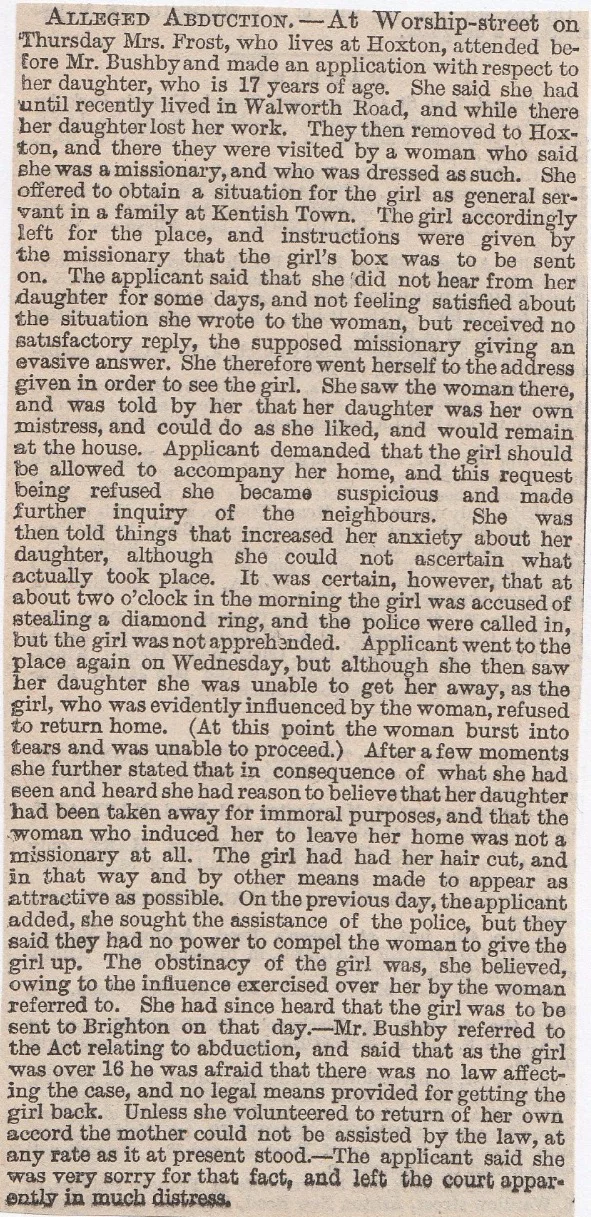
28/ Hoxton Suicide, March 1866
Committing suicide when you don’t get invited to tea is a first for me. Mary Ann Hutchens aged 28, worked herself up into a frenzy when her sister, Elizabeth, got invited and she didn’t. So much so, that she did threaten to kill herself and this continued for an hour, and she had in her hands a teacup with boiling water in it. Her sister said “You shall not take that”, when Mary Ann laughed and screamed, “I don’t care for your upsetting it”. She went into the parlour then came back ten minutes later and said: ” I have done it “. Elizabeth immediately assumed that she had swallowed some poison and asked her if she had. The reply was “I have taken enough to settle me”, and she then passed out on her way upstairs. She then went into a coma and died soon afterwards. The surgeon stated she had taken enough to kill five or six people, and the verdict was “Suicide while in a state of temporary insanity from violent and excessive passion”. Never heard that verdict before. Spoiled cow more like!
29/ River Lea, Hackney, October 1892 (Suicide of a Policeman)
A police constable in the J Division, James Merriman, aged 39, drowned himself in the River Lea. Before he did this he wrote to the “Daily Chronicle” stating that he was called to the Queen’s Head pub by a lad. When he got there the publican told him in no uncertain terms that he was not required as he was going out, then met by an Inspector Smith, who reported him for being on licensed premises while on duty. He was fined three days pay and transferred to another division. He tried to appeal the decision but it was refused, and when the case came up in front of the judge, Merriman was let off and exonerated of any blame. The whole shenanigans had preyed upon his mind and he was upset that the false accusation had been made in the first place, so he jumped into the River Lea.
30/ Stoke Newington, July 1863 (Human Remains)
Yet another story of an undertaker not burying corpses but taking the money! This was Henry Chapman, an undertaker from West Hackney, and they found variously sized coffins in a shed, plus five adult coffins and eight children’s coffins. Also in the shed were two adult coffin’s, one with a plaque reading:-“Lucy Walters, June 12th, 1863, aged 67”. A thorough inspection was made and the report said “I have made two inspections of the bodies of three children who have been kept unburied for a considerable length of time. One died on the 7th of June last, and was in a very offensive state; another is stated to have died on the 23rd of March last; the remaining one on the 23rd of May,1862. Lime had been put into two of the coffins, but not the third”. The bodies were hardly recognisable and even the bones were powdery.
31/ Hackney, (Husband Murderer) October 1896

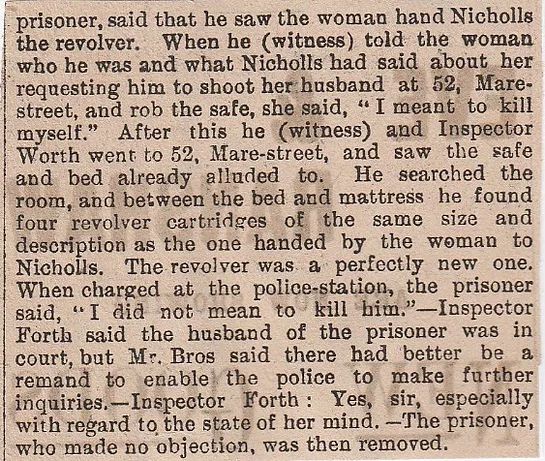
32/ South Hackney Church, April 1868 (Child Murder)
Alfred Searle, hansom cab driver(Cab No 16,090), was hailed by a customer at Gracechurch Street in the City by a man and a woman who climbed into his cab and asked to be taken to South Hackney Church. They arrived at their destination and both got out, but the man told the lady to carry on and he would overtake her. He stopped and paid the two shillings and sixpence fare. Searle then drove to London Bridge Railway Station, when he checked the cab he found a black leather bag where the woman had been sitting. He opened it and saw the body of a boy wrapped in a flannel petticoat. He went to police straight away and told them that he would recognise the man, but not the woman as she was covered up and wore a hat low over her face. The baby boy had lived but was suffocated when only a few hours old, and now it is in the hands of the police and is a murder case.
33/ Dalston Suicide, November 1855
40-year-old Charles Moseley, of 16 Middleton Road, Dalston had been a clerk in the Bank of England for numerous years. One night he had a dream that police were after him, in pursuit of some forgeries upon the Bank. He went to work the next day and although there was no foundation in the fact, it kept playing on his mind, and he was clearly distressed by the dream. His wife told him to forget it and “It’s just a dream” lecture was rattled off to him, but he had the exact same dream again on another night. He woke up in a sweat, went downstairs and got a carving knife from the kitchen and tore open his abdomen. His wife entered shortly after and managed to get the help of a policeman, who prevented him doing any more damage to his innards. A doctor was procured and despite his bowels protruding from the gash he talked calmly and perfectly conscious all the time. About three hours later he began to fade and finally died from the self-inflicted stab wounds.
34/ Hoxton Murder, April 1887
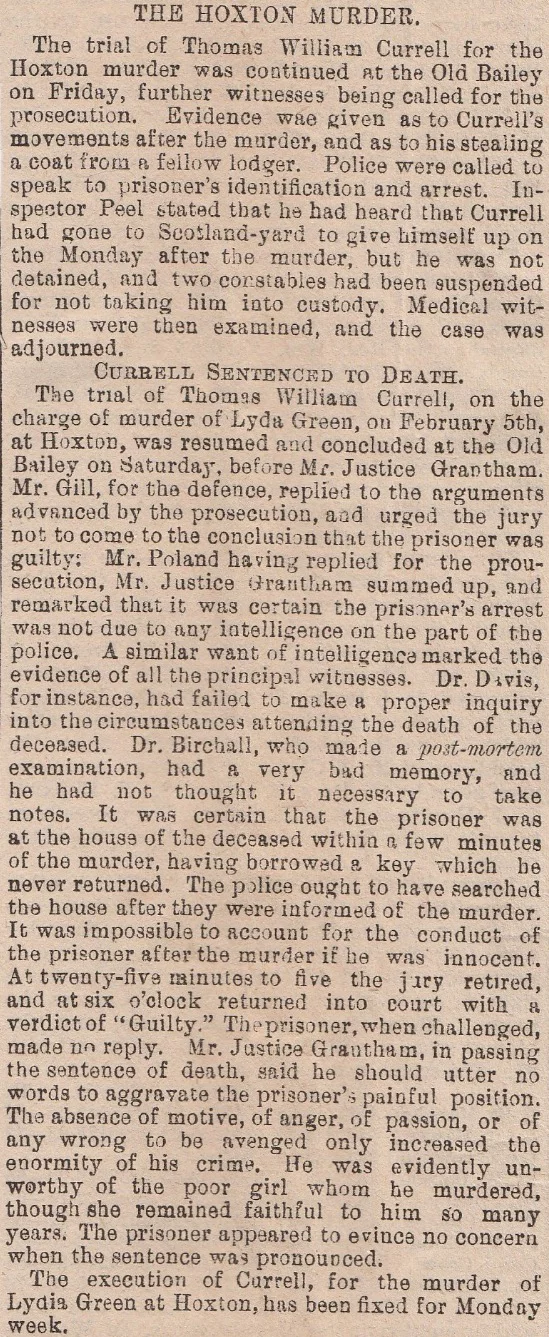
35/ Kingsland Road, February 1899 (I think it’s in Hackney)
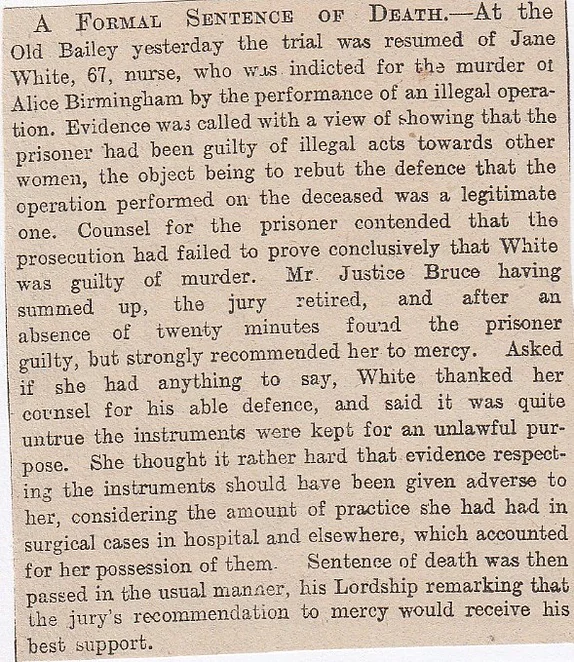
36/ Mill Row, Hoxton (Child Starvation) July 1870 (Mill Row still there- 11 looks like old terrace and 13 is a new build)
37/ Fatal Fire at Shoreditch (Old Castle St) October 1870
38/ Fatal Fire on Hackney Road, October 1903. (Near Mansford St, off Hackney Road. Next to Lion Mills, No’s 396/394)
39/ Murdered Baby in Hackney Churchyard, October 1904.
40/ Ex-Soldier Murders Girlfriend, Dalston. July 1904.
41/ Burned to Death in her Nightie, January 1904.
An inquest was held yesterday, on the body of Elizabeth Molyneux, aged twenty-four, whose home was in Cutler Street, Birmingham, and who had lately been employed as a probationer on the nursing staff of the Hackney Infirmary. On Wednesday morning last Miss Molyneux was preparing to go to bed, after having been on duty throughout the night, when the flannelette nightdress which she had put on came in contact with the fire in her bedroom and she was became enveloped in flames. In her fright she ran through the corridor to another nurse’s bedroom, where the flames were smothered; but Miss Molyneux was very severely burnt, and she died the next day from the effects of the burns and shock. The Coroner commented on the dangers of flannelette, and the jury returned a verdict of ” Accidental Death”.
42/ Fatal Fire in Shoreditch, January 1904.
A fire broke out soon after 3 o’clock on Saturday morning at 18, Bartholomew Square, Old Street, Shoreditch, in a house rented by a family named Saterly, and sub-let to lodgers. The back room on the first floor was rented by a lodger named Edward Jacobs, who was seventy-six years of age. The first intimation that the other occupants of the house received of the fire was the sudden falling in of the flooring into the ground-floor. Immediately after the floor fell in, the entire house took fire. When the firemen from Shoreditch, Hackney, and other stations had overcome the fire a search was made, and the remains of Jacobs were found in the ruins.
43/ Volunteer’s Shocking Suicide, Stoke Newington July 1904.
44/ Child Murder in Hoxton Street, Shoreditch. February 10th, 1904
Thursday, February 11th, 1904.
Lucy Elizabeth Strong, 38, a married woman, who was found guilty yesterday of the manslaughter of her infant child, Sarah Strong, was brought up for judgment. The defendant expressed her willingness to go for a time to a home which had been found for her by the Court missionary, Mr France, and her husband said he was willing to contribute to her support.
45/ Manslaughter of Husband & Wife, Shaftesbury Ave, Hoxton. November 1906.
46/ Death Caused By Alcoholism, Hoxton. January 1906
Dr Westcott conducted an inquiry on Tuesday at Shoreditch concerning the death of Alice Maud Sanderson, thirty-eight, of Charlotte Street, Hoxton. The husband said the deceased had of late given way to drinking. He had implored her to refrain from taking spirits, but she he had, he discovered, been drinking gin in large quantities. On Saturday night witness went to bed at 10-30 p.m. When he awoke next morning his wife was missing, and upon searching the house he was horrified to find her lying dead at the bottom of the stairs. In one hand was a bottle of gin, and in the other, she clutched hold of some money. Medical evidence showed that death was due to suffocation owing to the deceased being unable to help herself whilst in an intoxicated condition. A verdict of “Accidental Death” was recorded.
47/ Young Woman Burned to Death, Clapton Road, Clapton. June 1907
48/ Death by Alcoholic Poisoning, Homerton. November 1880 (139 Clifden Road is still there, near Glyn Road end)
49/ Suicide in Union Street, Shoreditch. October 1880
An inquest was held at the Shoreditch Town Hall on the body of Emma Maria Hill, who committed suicide by hanging herself on Wednesday last. Charles Hill, builder, of 24, Union Crescent, Union Street, Shoreditch, husband of the deceased, said that on Wednesday morning he heard that his wife had committed suicide, and on going to the house he found her hanging from the top of the bedstead. Witness and his wife had quarrelled in consequence of her immoralities, and his discovery of her conduct seemed to have preyed heavily on her mind. Mary Elizabeth Hill, aged nine, daughter of the deceased, found her mother hanging from the top of the bedstead. Jury’s verdict- “Suicide whilst of unsound mind”.


